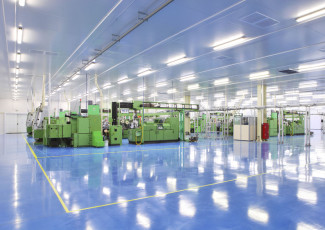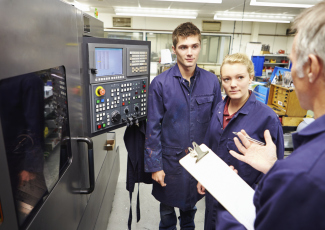Earn While You Learn: The Impact of Apprenticeship
By Corey Murray
April 11, 2014
The White House’s new apprenticeship consortium highlights the need for hands-on workforce training. But, as a new guide from the American Association of Community Colleges demonstrates, many of the nation’s two-year career and technical colleges may well be ahead of the game.
It was a pretty big week for higher education. While Vice President Joe Biden spoke to community college leaders at the American Association of Community Colleges (AACC) annual convention, President Obama was in Maryland peeling back the curtain on a $100 million grant initiative to streamline student pathways from school to work.
In Washington, Biden joined his wife, Jill—an English professor at Northern Virginia Community College—to unveil a new consortium that brings colleges and businesses together to create apprenticeship programs for students in pursuit of jobs in high-demand career fields.
Biden said the consortium, which you can read more about on AACC’s Community College Daily, would buoy the nation’s struggling middle class and provide hundreds of thousands of opportunities for American workers to “earn while they learn.”
With the gap between jobs and workers with the technical know-how needed to fill those jobs widening seemingly by the day, if not the hour, the administration’s latest full-court press for job training makes good political and economic sense.
As Biden put it, “Unless we have the most skilled workforce in the world, we will not be able to lead the world.”
But, it’s not as if the nation’s community colleges, which Biden called “the heart of expanding opportunity” for millions of middle-class Americans, have been shy about reaching out to businesses about hands-on training for students. In many ways, they’ve been out in front, leading the movement.
Promising practices
In a new report, “Empowering Community Colleges to Build the Nation’s Future: An Implementation Guide,” AACC highlights dozens of promising practices for community colleges to consider in their quest to improve graduation rates and, ultimately, career opportunities for students.
The nation’s two-year career and technical college leaders are so zeroed in on closing the nation’s skills gap that AACC dedicated a full chapter of its latest guide to the challenge.
Among the programs highlighted in the guide, a series of stackable credentials offered through William Rainey Harper College in Illinois that aligns students with paid internships at 54 different regional and local employers and a virtual incubator network at White Mountains Community College in New Hampshire that provides online assistance to small business entrepreneurs looking to create jobs in remote rural communities.
Elsewhere in the U.S.
AACC’s new report details a handful of promising initiatives. But they are far from the only programs to demonstrate the power and reach of college and workforce partnerships.
At Central Piedmont Community College in North Carolina, administrators have long worked with technology innovator Siemens to create a pipeline of quality employment candidates with advanced technical skills. That program, singled out by President Obama in his 2012 State of the Union Address, offers paid apprenticeships for students in the college’s mechatronics program. Participating students have an opportunity to collect a paycheck and advance their careers while they earn credits at the college.
Further north, in New York State, administrators at Rockland Community College (RCC) are inviting manufacturers onto campus and encouraging them to use their facilities to conduct research and innovation.
The college recently installed a 3D printing lab, where local and regional manufacturers and students are invited to experiment with the technology.
“This is a sandbox,” Thomas P. Della Torre, RCC’s associate vice president of academic and community partnerships, told the Journal News for a story. “This is a place for manufacturers to come and work and play and test and prototype and experiment and train.”
Gaining momentum
As if Biden’s speech to community college leaders wasn’t enough to prove just how high a price the administration places on these types of public-private alliances, President Obama drove the point home during a visit to Bladensburg High School in Prince George’s County, Md.
“We want to invest in your future,” Obama told students as he unveiled his administration’s new Youth CareerConnect initiative. The $107 million grant initiative supports partnerships that bring schools, colleges, workforce investment boards, employers and other stakeholders together to create pathways from education to work in high-demand job fields, such as health care and information technology.
The school, located less than 30 minutes from the White House, is one of three schools in the region that will receive part of a $7 million award, one of 24 such awards given to different schools across the country. (Learn more about the program in the White House video below.)
“You guys are all coming up in an age where you’re not going to be able to compete with people across town for good jobs,” Obama told students. “You’re going to be competing with the rest of the world.”
What’s your college doing to better prepare its students for success in the global marketplace?














